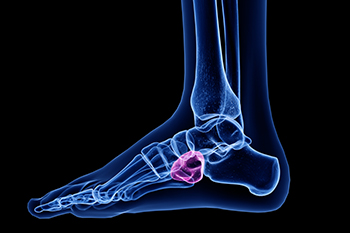
Drexel Hill (484) 521-0233
West Chester (610) 436-5883

Drexel Hill (484) 521-0233
West Chester (610) 436-5883

Millions of people in the United States experience chronic foot pain, which can interfere with daily activities. Common causes can include bunions, which are painful bumps at the base of the big toe caused by joint misalignment. This condition is often managed with wearing roomier shoes or, in severe cases, surgery. Fallen arches, resulting from a loss of tendon elasticity, can lead to pain in the arch, ankle, and leg. Typical treatment includes supportive insoles and certain stretching exercises. Hammertoes, where a toe bends abnormally and rubs against shoes, can cause discomfort that may be relieved by changes in footwear or undergoing surgery, if necessary. Ingrown toenails, frequently the result of improper nail trimming, can cause pain and swelling, often requiring professional care to prevent infection. Lastly, plantar fasciitis is a common cause of heel pain stemming from tiny tears in the foot's supporting tissue. Relief may be found from practicing specific stretches, wearing heel inserts and night splints. If you are experiencing any type of foot pain, it is suggested that you schedule an appointment with a podiatrist for a diagnosis and appropriate treatment solutions.
Foot Pain
Foot pain can be extremely painful and debilitating. If you have a foot pain, consult with the podiatrists from Dr. Siegerman & Associates. Our doctors will assess your condition and provide you with quality foot and ankle treatment.
Causes
Foot pain is a very broad condition that could be caused by one or more ailments. The most common include:
Diagnosis
To figure out the cause of foot pain, podiatrists utilize several different methods. This can range from simple visual inspections and sensation tests to X-rays and MRI scans. Prior medical history, family medical history, and any recent physical traumatic events will all be taken into consideration for a proper diagnosis.
Treatment
Treatment depends upon the cause of the foot pain. Whether it is resting, staying off the foot, or having surgery; podiatrists have a number of treatment options available for foot pain.
If you have any questions, please feel free to contact one of our offices located in Drexel Hill and West Chester, PA . We offer the newest diagnostic and treatment technologies for all your foot care needs.

Walking and running shoes are designed with distinct features to accommodate the different needs of each activity. Walking shoes typically offer more flexibility and cushioning in the heel and arch to support the rolling motion of the foot during walking. They often have a more rigid sole to provide stability and promote a natural gait. Conversely, running shoes feature more shock absorption and cushioning in the heel and forefoot to handle the higher impact and repetitive stress of running. They are designed with more advanced shock-absorbing materials and often have a curved sole to enhance propulsion and forward motion. While both types of shoes aim to provide comfort and support, choosing the right shoe for your activity can help prevent injuries and improve performance. Foot injuries may happen from wearing the wrong type of shoe for your desired form of exercise, and can be treated by a podiatrist. If this applies to you, it is suggested that you contact this type of doctor who can offer treatment solutions, in addition to guiding you on choosing the right type of running or walking shoe.
For more information about walking shoes versus running shoes, consult with the podiatrists from Dr. Siegerman & Associates. Our doctors can measure your feet to determine what your needs are and help you find an appropriate pair of footwear.
Foot Health: The Differences between Walking & Running Shoes
There are great ways to stay in shape: running and walking are two great exercises to a healthy lifestyle. It is important to know that running shoes and walking shoes are not interchangeable. There is a key difference on how the feet hit the ground when someone is running or walking. This is why one should be aware that a shoe is designed differently for each activity.
You may be asking yourself what the real differences are between walking and running shoes and the answers may shock you.
Differences
Walking doesn’t involve as much stress or impact on the feet as running does. However, this doesn’t mean that you should be any less prepared. When you’re walking, you land on your heels and have your foot roll forward. This rolling motion requires additional support to the feet.
Flexibility – Walking shoes are designed to have soft, flexible soles. This allows the walker to push off easily with each step.
If you have any questions, please feel free to contact one of our offices located in Drexel Hill and West Chester, PA . We offer the newest diagnostic and treatment technologies for all your foot care needs.

Diabetic neuropathy is a serious complication of diabetes that results from nerve damage caused by prolonged high blood sugar and elevated blood fats. This condition often targets the nerves in the lower legs and feet, leading to what is known as peripheral neuropathy. Studies show that between one-third and one-half of people with diabetes will experience this condition. Diabetic neuropathy can bring on a range of uncomfortable symptoms, including numbness and weakness, burning, tingling, and pain in the lower limbs. Additionally, the diminished sensation can make you more susceptible to unnoticed wounds on your feet, which increases the risk of infections and complications. To manage diabetic neuropathy effectively, it is suggested you schedule an appointment with a podiatrist, ensuring that any potential issues are caught early and treated appropriately.
Neuropathy
Neuropathy can be a potentially serious condition, especially if it is left undiagnosed. If you have any concerns that you may be experiencing nerve loss in your feet, consult with the podiatrists from Dr. Siegerman & Associates. Our doctors will assess your condition and provide you with quality foot and ankle treatment for neuropathy.
What Is Neuropathy?
Neuropathy is a condition that leads to damage to the nerves in the body. Peripheral neuropathy, or neuropathy that affects your peripheral nervous system, usually occurs in the feet. Neuropathy can be triggered by a number of different causes. Such causes include diabetes, infections, cancers, disorders, and toxic substances.
Symptoms of Neuropathy Include:
Those with diabetes are at serious risk due to being unable to feel an ulcer on their feet. Diabetics usually also suffer from poor blood circulation. This can lead to the wound not healing, infections occurring, and the limb may have to be amputated.
Treatment
To treat neuropathy in the foot, podiatrists will first diagnose the cause of the neuropathy. Figuring out the underlying cause of the neuropathy will allow the podiatrist to prescribe the best treatment, whether it be caused by diabetes, toxic substance exposure, infection, etc. If the nerve has not died, then it’s possible that sensation may be able to return to the foot.
Pain medication may be issued for pain. Electrical nerve stimulation can be used to stimulate nerves. If the neuropathy is caused from pressure on the nerves, then surgery may be necessary.
If you have any questions, please feel free to contact one of our offices located in Drexel Hill and West Chester, PA . We offer the newest diagnostic and treatment technologies for all your foot care needs.

Cuboid syndrome, a condition affecting the foot, involves the cuboid bone, one of the seven tarsal bones located on the outer side of the foot. Positioned between the heel bone, which is also known as the calcaneus, and the 4th and 5th metatarsal bones, the cuboid bone plays a vital role in maintaining the arch of the foot and facilitating movement. This syndrome typically arises due to repetitive stress or trauma, such as overuse injuries common in athletes or sudden twists of the foot. The exact cause often involves the displacement, or subluxation, of the cuboid bone, leading to pain and discomfort on the outer edge of the foot, sometimes radiating into the toes. Symptoms may include swelling, tenderness, and difficulty bearing weight on the affected foot. If you have pain in this part of your foot, it is suggested that you visit a podiatrist who can provide an accurate diagnosis and treatment.
Cuboid syndrome, also known as cuboid subluxation, occurs when the joints and ligaments near the cuboid bone in the foot become torn. If you have cuboid syndrome, consult with the podiatrists from Dr. Siegerman & Associates. Our doctors will assess your condition and provide you with quality foot and ankle treatment.
Cuboid syndrome is a common cause of lateral foot pain, which is pain on the outside of the foot. The condition may happen suddenly due to an ankle sprain, or it may develop slowly overtime from repetitive tension through the bone and surrounding structures.
Causes
The most common causes of cuboid syndrome include:
Symptoms
A common symptom of cuboid syndrome is pain along the outside of the foot which can be felt in the ankle and toes. This pain may create walking difficulties and may cause those with the condition to walk with a limp.
Diagnosis
Diagnosis of cuboid syndrome is often difficult, and it is often misdiagnosed. X-rays, MRIs and CT scans often fail to properly show the cuboid subluxation. Although there isn’t a specific test used to diagnose cuboid syndrome, your podiatrist will usually check if pain is felt while pressing firmly on the cuboid bone of your foot.
Treatment
Just as the range of causes varies widely, so do treatments. Some more common treatments are ice therapy, rest, exercise, taping, and orthotics.
If you have any questions, please feel free to contact one of our offices located in Drexel Hill and West Chester, PA . We offer the newest diagnostic and treatment technologies for all your foot care needs.
Request a free copy of
Laser Away Foot Pain!
today.
